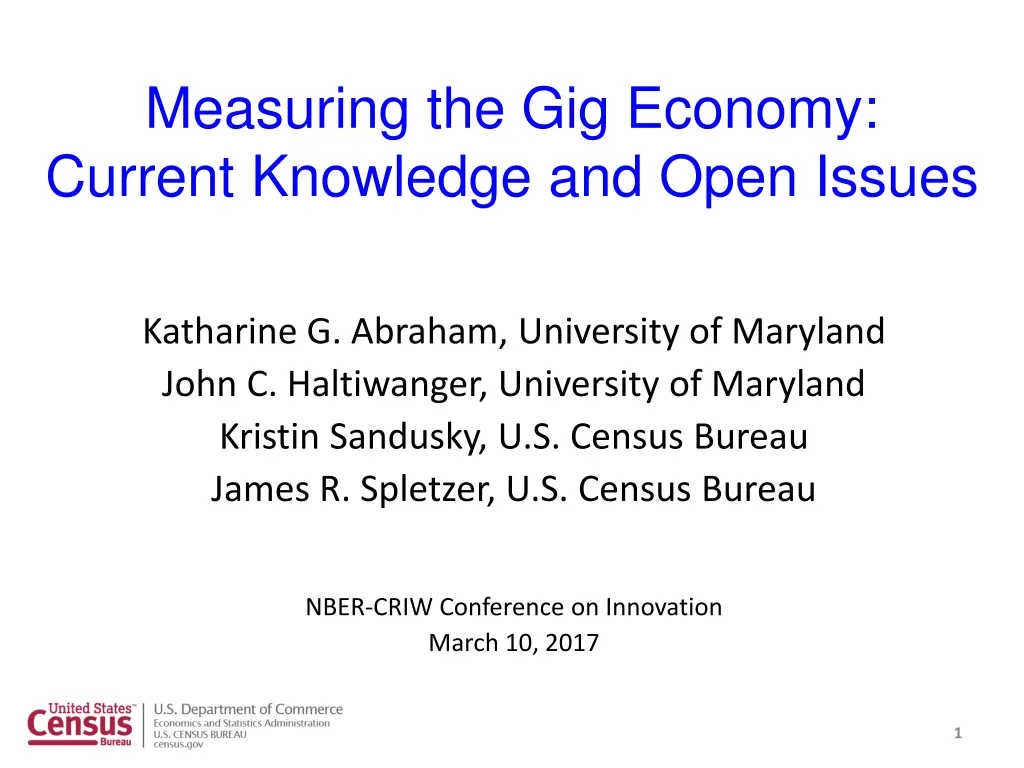
Understanding the Gig Economy: Current Insights and Research Findings
Delve into the dynamics of the gig economy through research conducted by experts from the University of Maryland and the U.S. Census Bureau. Explore the motivations, challenges, and nuances of non-traditional work arrangements, as well as strategies for analyzing and improving data on self-employment trends.
Download Presentation

Please find below an Image/Link to download the presentation.
The content on the website is provided AS IS for your information and personal use only. It may not be sold, licensed, or shared on other websites without obtaining consent from the author. If you encounter any issues during the download, it is possible that the publisher has removed the file from their server.
You are allowed to download the files provided on this website for personal or commercial use, subject to the condition that they are used lawfully. All files are the property of their respective owners.
The content on the website is provided AS IS for your information and personal use only. It may not be sold, licensed, or shared on other websites without obtaining consent from the author.
E N D
Presentation Transcript
Measuring the Gig Economy: Current Knowledge and Open Issues Katharine G. Abraham, University of Maryland John C. Haltiwanger, University of Maryland Kristin Sandusky, U.S. Census Bureau James R. Spletzer, U.S. Census Bureau NBER-CRIW Conference on Innovation March 10, 2017 1
Disclaimer Any opinions and conclusions expressed herein are those of the authors and do not necessarily represent the views of the U.S. Census Bureau. All results have been reviewed to ensure that no confidential information is disclosed. 2
Motivation Is new technology producing an accelerated pace of change in the organization of work? Is there dramatic growth in the number of workers with no long- term connection to a particular business? This leads to concerns about workers welfare Although workers may be voluntarily choosing these new non- traditional work arrangements This matters for economic measurement Employment, earnings, and productivity 3
Our Research 1) Describe the heterogeneity of non-traditional work 2) Document the different self-employment levels & trends in household survey data versus administrative tax data 3) Analyze linked household-administrative individual-level data to understand the different SE levels & trends 4) Suggestions and evidence for improving household survey data 5) Suggestions for how to make more effective use of administrative data 4
The heterogeneity of non-employee work Gig workers do not have an implicit or explicit contract for a continuing work relationship they are contingent workers But estimates of contingent work from the CWS do not provide an upper bound for gig workers CWS only asks about main jobs Gig workers are a subset of the unincorporated self-employed Unincorporated SE are measured in household surveys (need to be aware of the distinction between main job and second jobs) Most unincorporated SE should receive a 1099 and should file a Schedule C and Schedule SE Trends in unincorporated SE from both household survey and tax data are a first place to look for trends in gig employment 6
Self-employment levels and trends Can we say that household survey data or administrative tax data are more accurate? No CPS & ACS don t probe deeply about non-traditional work arrangements, leading to reporting errors Tax data only captures what is reported The best way to understand discrepancies between household survey data and administrative tax data is to compare information from the two sources for the same set of people We link the CPS-ASEC and the DER microdata, 1996-2012 8
Self-employment in CPS-ASEC and DER Average 1996-2012 10
Self-employment in CPS-ASEC and DER Average 1996-2012 11
Self-employed in DER but not in CPS-ASEC Each of the following three categories No CPS employment SE 2nd job not in CPS CPS W&S, DER SE contributes roughly 33% to the growth of the CPS{SE=0}, DER{SE=1} off-diagonal 13
Improving household survey measures The linked data show that a significant and growing number of people report self-employment income on schedule SE but do not report this on the CPS-ASEC 2/3 of growth is due to non-reported SE income in CPS-ASEC 1/3 of growth is due to misclassification (W&S versus SE) Would probing for non-traditional work arrangements improve their measurement on household surveys? One goal of a recent survey conducted by the Joint Program in Survey Methodology (JPSM) at the University of Maryland 14
JPSM survey Approximately 5000 subjects recruited using Mechanical Turk Respondents young and well-educated Weighted data, but not representative of the population The survey (see Abraham & Amaya for further detail): Asks CPS labor force questions for each household member Additional questions about informal (gig) employment asked about one randomly-selected member of the household asked a global yes/no gig employment question, asked about each of six possible types of gig employment Respondents asked if the gig work is reported in CPS job count 15
JPSM survey results Probing about gig employment leads to higher employment rates Probing about gig employment leads to much higher multiple job holding rates The global and the detailed probes have similar impacts for self respondents The detailed probes have a larger impact than the global probe for proxy respondents 16
Improving household survey measures There is growing recognition that: Household survey questions miss primary work activities if the respondent does not think of those activities as a job Household survey questions miss marginal jobs or activities that are not the individual s primary activity There is evidence of misclassification in class-of-worker data We recommend: More probing questions should be asked at regular intervals (supplements) to measure non-traditional work Probes should focus on both primary and secondary jobs Probes can be tailored differently for self versus proxy respondents 17
Making more effective use of administrative data Information about non-employee work could be derived from: Tax data, particularly 1099s (Jackson, Looney, & Ramnath) Financial data (Farrell and Greig) Private sector company data obtain personnel data from companies in the online platform sector (Hall & Krueger) We also want to mention employer surveys: ask employers if they use alternative work arrangements and for what functions (Annual Survey of Entrepreneurs is an example) 18
Making more effective use of administrative data A core theme emphasized in our paper is that integration of tax data, financial data, and private sector company data with survey and administrative data has the potential to add important new insights: Understand whether this non-traditional work is a primary or supplemental source of earnings Understand how non-employee work fits into the career path of individuals Properly weight the data originating from private companies Understand the family circumstances of gig workers, particularly with regard to health insurance coverage 19
Conclusions and a path forward The widely perceived rise of the gig economy is not well measured Gig workers are self-employed, but published levels and trends of self-employment differ dramatically across data sources Measuring the gig economy requires knowing where this activity fits into the full range of non-employee work We recommend two improvements in economic measurement: 1) Survey modules that probe more deeply about the non- employee work activities and the attributes of such work 2) Integration of survey and administrative data at the individual level 20

